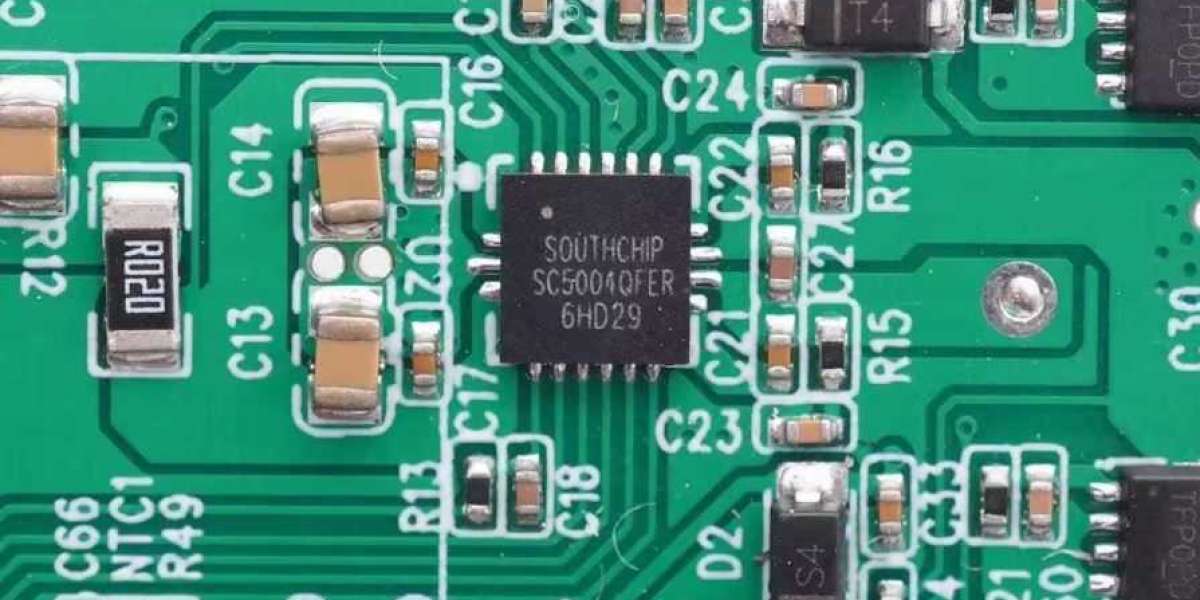In the world of electronics, capturing and processing real-world signals efficiently is critical to the functionality of many systems. An Analog Front End (AFE) chip plays a pivotal role in this process. It bridges the gap between the analog signals generated by sensors and the digital world where data is analyzed, processed, or stored. AFEs are widely used in medical devices, communication systems, industrial applications, and consumer electronics. This blog will explore the fundamentals of AFE chips, their role in various applications, and key factors to consider when selecting the right AFE for your project.

What Is an Analog Front End (AFE) Chip?
An Analog Front End (AFE) chip is an integrated circuit that processes and conditions analog signals from sensors or other sources before converting them to a digital format for further processing. The primary role of an AFE is to ensure that the analog signal is properly amplified, filtered, and conditioned to meet the requirements of an Analog-to-Digital Converter (ADC) or digital processing unit.
AFE chips typically include a combination of the following functions:
- Amplifiers: Boost weak analog signals to a level suitable for further processing.
- Filters: Remove unwanted noise and interference from the signal.
- Analog-to-Digital Converters (ADCs): Convert the conditioned analog signal into a digital format.
- Multiplexers: Select between multiple input channels, allowing multiple signals to be processed by a single ADC.
By integrating these functions, AFE chips streamline the design of electronic systems, reduce component count, and improve overall signal integrity. In many applications, AFEs are critical for ensuring accurate and reliable data acquisition.
Components and Functions of Analog Front End (AFE) Chips
AFE chips are complex systems that incorporate several essential components designed to handle different aspects of signal processing. These components enable AFEs to optimize the signal before digitization, ensuring precision and minimizing errors.
1. Amplifiers
One of the core components of an AFE chip is the amplifier. Many sensors, such as temperature sensors, pressure sensors, or biomedical electrodes, generate weak analog signals that need to be amplified before further processing. AFEs typically include one or more low-noise amplifiers (LNAs) or programmable gain amplifiers (PGAs) to increase the signal amplitude without introducing significant noise.
Low-noise amplifiers (LNAs) are designed to amplify very small signals, such as those produced by sensors in medical or environmental monitoring applications, while minimizing noise. This is crucial for applications where signal accuracy is paramount, such as in electrocardiograms (ECGs) or EEG monitoring.
Programmable gain amplifiers (PGAs), on the other hand, allow the gain of the amplifier to be adjusted dynamically, enabling the system to handle a wide range of input signals. This versatility is particularly useful in applications where signals may vary in strength, such as wireless communication systems or industrial sensors.
2. Filters
In many applications, raw analog signals contain unwanted noise or interference that can distort the final data if not properly filtered. AFE chips often include analog filters that clean up the signal before it reaches the ADC. The type and characteristics of the filter depend on the application and the nature of the noise present in the environment.
Low-pass filters are used to eliminate high-frequency noise from the signal, which is particularly important in systems where only low-frequency signals are of interest (e.g., biomedical applications). Bandpass filters, on the other hand, allow signals within a specific frequency range to pass through while blocking frequencies outside that range.
Advanced AFE chips may include programmable filters, which allow designers to customize the filter characteristics depending on the specific needs of the system. This flexibility enables AFEs to be used in a wide range of applications without requiring extensive redesigns.
3. Analog-to-Digital Converters (ADCs)
While not always included in every AFE, many chips integrate Analog-to-Digital Converters (ADCs), which convert the conditioned analog signal into a digital format that can be processed by microcontrollers or other digital systems. The inclusion of an ADC makes the AFE a comprehensive solution for handling the entire analog-to-digital signal chain.
ADCs are typically characterized by their resolution (measured in bits) and sampling rate (measured in samples per second). Higher resolution ADCs offer more precise conversions, while higher sampling rates allow for the capture of faster-changing signals. Some advanced AFE chips feature delta-sigma ADCs, which provide high-resolution and low-noise performance, making them ideal for sensitive applications like medical diagnostics or high-precision industrial monitoring.
4. Multiplexers and Sensor Interfaces
Many applications require data to be collected from multiple sensors or input sources. To handle this, AFE chips often include multiplexers that allow the system to select between different input channels. This reduces the need for multiple ADCs and simplifies the design of multi-sensor systems.
Multiplexers are particularly useful in applications like environmental monitoring or industrial automation, where data from various sensors (e.g., temperature, humidity, pressure) must be collected and processed by a single system.
Applications of Analog Front End (AFE) Chips
AFE chips are used in a wide range of industries and applications, offering reliable signal processing solutions for various types of sensors. Below, we explore some key areas where AFEs are indispensable.

1. Medical Devices and Healthcare
In the medical field, AFE chips are integral to the design of diagnostic and monitoring equipment, where accurate signal acquisition and processing are essential for patient care.
For example, in electrocardiogram (ECG) machines, AFE chips amplify the tiny electrical signals generated by the heart and filter out noise, ensuring that healthcare professionals can accurately assess a patient’s heart rhythm. Similarly, electroencephalogram (EEG) devices, which monitor brain activity, rely on AFE chips to process the weak electrical signals produced by neurons.
AFE chips are also used in blood glucose monitors, pulse oximeters, and ultrasound machines, where they help convert biological signals into digital data for analysis. In each case, the ability of the AFE to provide low-noise amplification and filtering is critical to ensuring the reliability of the measurements.
2. Industrial Automation and Control Systems
In industrial environments, AFE chips are used to process signals from a wide range of sensors, enabling systems to monitor and control machinery, optimize production processes, and ensure safety.
Process control systems often rely on AFEs to capture data from sensors measuring temperature, pressure, flow rates, or vibration. The AFE conditions these signals, ensuring that they can be accurately interpreted by the system's control algorithms. In industrial predictive maintenance systems, AFEs help monitor machinery for early signs of wear or failure, allowing maintenance to be performed before a breakdown occurs.
In factory automation, AFEs are used to interface with various types of sensors, such as strain gauges or accelerometers, to optimize machine operation and ensure the quality of manufactured products. These systems require highly accurate and low-noise signal processing to maintain optimal performance.
3. Communication Systems
In telecommunications and wireless communication systems, AFE chips play a crucial role in processing analog signals received from antennas or other communication channels.
In radio receivers, for example, AFEs condition and amplify the weak signals received by the antenna, ensuring that the subsequent digital processing stages can extract the correct information from the signal. In wireless communication systems, AFEs are used to improve the quality of the signal and minimize the effects of interference or noise.
AFE chips also play a key role in cellular base stations and satellite communication systems, where they enable the reliable transmission and reception of signals across long distances.

Key Considerations When Choosing an AFE Chip
Selecting the right AFE chip for your application involves evaluating several critical factors. The specific needs of your system, the environment in which it operates, and the types of signals being processed will all influence your decision.
1. Signal Type and Range
The type of sensor and the range of signals it produces will determine the specifications required of the AFE. For example, if you are working with very small signals, such as those generated by biomedical sensors, you’ll need an AFE with a low-noise amplifier to ensure accurate signal capture.
If your system needs to handle a wide range of signal amplitudes, look for AFEs that offer programmable gain amplifiers (PGAs), which allow the gain to be adjusted dynamically depending on the input signal.
2. Noise Performance
In many applications, especially medical and industrial systems, noise can significantly affect the accuracy of your signal. Look for AFEs with low noise figures and high signal-to-noise ratios (SNRs) to ensure that your data is as accurate as possible.
3. Power Consumption
Power efficiency is another important consideration, especially in portable or battery-powered devices. Many AFE chips are designed with low-power modes to extend battery life, making them ideal for applications like wearable health monitors or remote environmental sensors.
4. Integration and Flexibility
If you are designing a system with multiple sensors or input channels, consider AFEs that integrate multiplexers or support a wide range of input types. This can simplify your design and reduce the need for additional components.
Conclusion
Analog Front End (AFE) chips are the backbone of signal acquisition and processing in a wide variety of applications. From medical devices and industrial automation to communication systems, AFEs enhance the quality and reliability of the signals captured from the physical world. Their ability to amplify, filter, and convert signals into a format that can be easily processed.
About Us
MobikeChip offers a broad range of genuine electronic components from over 2,600 manufacturers at competitive prices. Our product portfolio includes Integrated Circuits (ICs), Discrete Semiconductor Products, Resistors, Capacitors, Relays, Switches, Transformers, Sensors, Transducers, Inductors, Coils, Chokes, Potentiometers, Variable Resistors, Crystals, Oscillators, Resonators, Connectors, Interconnects, Memory Cards, Modules, Fans, Thermal Management products, and more.
Analog Front End (AFE) Category page:
https://www.mobikechip.com/static-product-list-detail/10434.html








